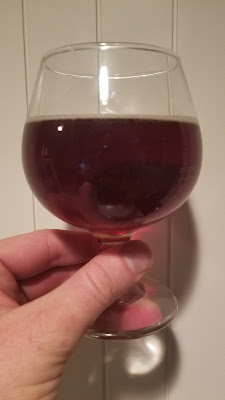I've never heard of a beer being made with caviar, and am skeptical as I'm not sure what it would add to the beer. Champagne yeast is an interesting, yet understandable choice; it's a medium-attenuating, clean, and neutral yeast with a propensity for a very bubbly end product. Salt is not an uncommon ingredient; you may recall I reviewed an Israeli dry stout in 2016. So I've got some idea what to expect - dark, dry, slightly salty, probably not too boozy.
Since I was working on New Year's Eve and didn't get a chance to celebrate, this is my celebratory champagne...beer...thingy. Cracks open from the tallboy can with little fanfare, and when poured into the glass it generates a heavy aroma of malt, and frankly some of the darkest foam I have ever seen - almost chocolate brown.
First thought - wow. Very strong malts, a massive wave of booziness accompanied by sea salt and brine - I guess that's what caviar tastes like? I'm not detecting any chocolate notes or cocoa notes - something I usually expect from dark stouts - and instead that salt plays a big role and makes the beer surprisingly savory. Texture is very smooth, not at all bubbly like champagne yeast would suggest. In terms of texture it's quite velvety, but presents a bit of freshness - in this way, it's quite similar to Snitz Creek's "Seltzer's Smokehaus No. 9", especially that salty savoriness. It's soft on the way out, but leaves a long lingering finish of sea salt that I really enjoy.
I definitely expected a darker, roastier beer (especially at 14.00%) but was surprised at how savory and soft it was. The salt is most welcome and turns what could have been just another overpowered, sweet, oily stout into a really fantastic offering. Since it's so unlike a stout, I highly recommend this for those interested in dark beers but don't like oily or roasted flavors. I was also surprised at the booziness; I expected it to be softer but it's really quite pronounced.
I'm not sure how available this is - we got it in the shop only briefly - and it's also available in a 750mL, but it's unclear if that's available in the US or only in Denmark. I bought this 16oz can for $9.99. In any event, if you see this can, get it. It's worth a try and will surprise you.
















